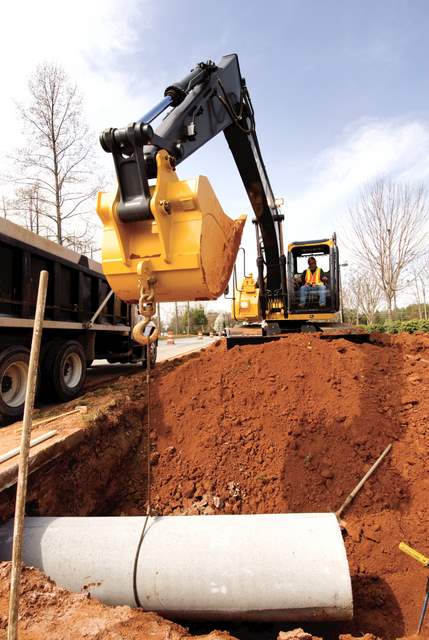New Report Warns of Strain on U.S. Cities to Maintain Assets and Build Infrastructure Projects as Federal Funding Declines
 America’s infrastructure investments — levels of which have long trailed behind those of Asia and Europe — will be further stifled this year by pressures to cut federal spending and reduce the deficit, compelling cities to be evermore creative and resourceful in securing partnerships to start or continue infrastructure projects, according to Infrastructure 2011: A Strategic Priority. The report, recently released by the Urban Land Institute and Ernst & Young, emphasizes the challenge faced by many urban areas trying to provide adequate transportation and other infrastructure services for their residents, workers and businesses.
America’s infrastructure investments — levels of which have long trailed behind those of Asia and Europe — will be further stifled this year by pressures to cut federal spending and reduce the deficit, compelling cities to be evermore creative and resourceful in securing partnerships to start or continue infrastructure projects, according to Infrastructure 2011: A Strategic Priority. The report, recently released by the Urban Land Institute and Ernst & Young, emphasizes the challenge faced by many urban areas trying to provide adequate transportation and other infrastructure services for their residents, workers and businesses.
Outside of the United States, “in most of the developed world and in many emerging markets, countries have committed to fulfilling infrastructure agendas as essential for sustaining or enhancing living standards in an increasingly competitive global marketplace,” says the report, which looks at infrastructure investments on six continents. (Expenditures for global infrastructure requirements over the next 25 years are currently estimated at $50 trillion.) Among the countries in which infrastructure is a top priority:
1. The UK — despite an austerity budget — has committed $326 billion over the next five years for projects related to rail, energy production and broadband access broadband.
2. France, Germany and Spain continue to build high-speed rail and freight networks between cities and as extended cross-border links.
3. Australia is focusing on port expansion, rail rebuilding and traffic congestion relief projects.
4. China is funding a host of wide-ranging infrastructure programs, including completion of a 10,000-mile high-speed rail network by 2020. Other projects include new airports, ports and transit systems, all of which contribute to China’s standing as the world’s second-largest economy.
5. India is actively seeking private financing for desperately needed infrastructure to sustain growth and meet its economic potential.
6. And Brazil is pushing ahead with road, transit and water projects to accommodate its fast-growing economy, and to prepare for upcoming World Cup and Summer Olympics games.
“Whether in countries with mature economies or in emerging markets, government and business leaders have found a way to develop and execute on well-established national infrastructure policies and programs,” comments Malcolm Bairstow, Ernst & Young’s Global Leader of Infrastructure and Construction. “Many of these countries’ long-term view of the future economic importance of sound infrastructure planning has allowed them to be both strategic and more efficient in developing and directing funding for major projects.”
“For those who have read our infrastructure reports over recent years, one consistent finding is that the U.S. seriously lags behind the rest of the world in addressing its infrastructure issues,” said Howard Roth, Ernst & Young’s Global Real Estate Leader. “The U.S. is facing increasing federal, state and municipal budget deficits, and lacks any type of comprehensive national policy or the political will to develop a long-term approach to funding the significant maintenance needs of aging U.S. infrastructure, much less the modernization and greenfield development of critically-needed new projects. We need to refocus our priorities: streamline the procurement process, attract private capital more efficiently, strategically invest in projects with national merit, and regain our stature as a global competitor. We need to take a page out of the playbooks of several nations around the world highlighted in our report, or we face the risk of serious deterioration of our country’s economic and social well-being.”
With $2 trillion needed just to repair and rebuild deteriorating roads, bridges, water lines, sewage treatment plants and dams, the nation’s infrastructure woes will only get worse, as the politically fractured government erodes support for both existing upgrades and new initiatives, noted ULI Executive vice president Maureen McAvey. (Public spending on transportation and water infrastructure as a share of the U.S. gross domestic product peaked at 3.1 percent in 1963, then declined steadily to 2.4 percent in 2007, according to Congressional Budget Office data.)
“America’s unwillingness to confront its infrastructure challenges is undermining the ability of our urban areas to compete globally. If we persist with short-sighted decisions, we will lose talented workers and companies to nations and cities overseas that are committed to infrastructure as a vital component of livability and economic viability,” McAvey said. “Infrastructure as a national priority is not political rhetoric. It’s a must to keep America’s standing as a global leader in innovation.”
To download a copy of Infrastructure 2011: A Strategic Priority, click here.

Comments are closed here.